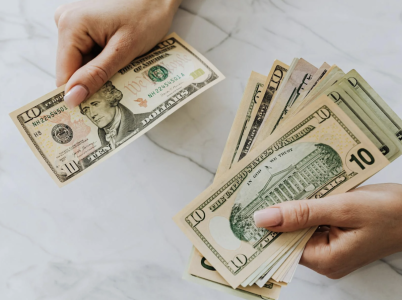This financial program is quietly giving $850 a month—here’s who qualifies
By
Veronica E.
- Replies 0
What would you do with an extra $850 each month—no strings attached?
For hundreds in one US state, that question isn’t just a thought experiment—it’s becoming part of their daily lives.
A new initiative is quietly delivering monthly payments to those facing financial challenges, and early reports suggest it’s already making a difference.
While traditional welfare programs often come with strict rules or income penalties, this effort takes a different approach.
Could it signal a broader shift in how we support those most in need? Here's what we know so far—and why many are watching closely.

Providing stability where it’s needed most
The In Her Hands program is delivering up to $20,400 in direct payments to 654 low-income women across three Georgia communities.
That money—spread over two years—is designed to provide financial breathing room for women facing daily economic challenges.
One recipient described the difference it’s made: “I’ve been able to pay all of my household bills every month, keep them on track. I paid off a couple of things I needed to pay off. So it’s really been a plus for me. I am so grateful.”
Why the focus on women?
Recent years have been financially difficult for many, but women—especially women of color and single mothers—have faced disproportionate hardship.
From rising prices to stagnant wages and the lasting effects of the pandemic, many have struggled to stay afloat.
The program has two main goals:
Also read: A new program is giving families $1,000 a month—could it reshape the safety net?
Where the program is being offered
In Her Hands focuses on three areas in Georgia with high poverty rates among women:
Who qualifies for the payments?
The eligibility criteria are intentionally simple:
Unlike many traditional programs, there are no work requirements, drug testing, or paperwork hurdles.
The goal is to make access as easy as possible for those in need.
Also read: US communities testing cash payment programs—could yours be next?
How the monthly payments are structured
Participants were randomly assigned to one of two groups:
This flexible structure allows the program to measure how different payment formats affect outcomes like debt reduction, emergency preparedness, and long-term financial well-being.
Also read: Medicare grocery allowance: Are you missing out on this food benefit?
Understanding guaranteed income and how it differs from welfare
You may have heard terms like guaranteed income (GI) or universal basic income (UBI).
Here’s the difference:
Programs like In Her Hands fall under the GI category. Unlike traditional welfare, GI does not penalize recipients for working or increasing their income, and payments are designed to supplement—not replace—other earnings or support.
Also read: Monthly payments with no strings? This program is changing how we think about financial help
What early results are showing
After just one year, participants are already seeing real progress:
These improvements suggest that even modest, consistent financial support can lead to greater financial resilience and reduce the stress of daily survival.
Also read: Could monthly payments like this change how Americans live?
The bigger picture: a growing movement with strong opinions
Guaranteed income programs are gaining popularity across the US, especially after the 2021 American Rescue Plan gave cities more flexibility to test new approaches.
Still, the concept is not without critics. Some states, like Texas and Iowa, have attempted to block such programs, citing concerns about cost or long-term dependency.
Supporters argue that GI creates a stable platform for individuals to pursue work, education, or caregiving without fear of losing other benefits.
What comes next?
As data from In Her Hands continues to emerge, cities and states across the country are watching.
Will this become a national model for economic security—or remain a small-scale experiment?
For the women currently enrolled, the impact is already clear, and many hope to see similar opportunities spread to other communities.
Read next: Help with rising energy bills: See if your state offers relief

Have you or someone you know taken part in a guaranteed income program? Do you think this approach has the potential to reshape how we fight poverty in America? Or do you have concerns about how these programs are funded or scaled? Join the conversation—your perspective matters.
For hundreds in one US state, that question isn’t just a thought experiment—it’s becoming part of their daily lives.
A new initiative is quietly delivering monthly payments to those facing financial challenges, and early reports suggest it’s already making a difference.
While traditional welfare programs often come with strict rules or income penalties, this effort takes a different approach.
Could it signal a broader shift in how we support those most in need? Here's what we know so far—and why many are watching closely.

A growing number of women are receiving monthly support to help manage bills, debt, and everyday expenses. Image Source: Pexels / Photo By: Kaboompics.com.
Providing stability where it’s needed most
The In Her Hands program is delivering up to $20,400 in direct payments to 654 low-income women across three Georgia communities.
That money—spread over two years—is designed to provide financial breathing room for women facing daily economic challenges.
One recipient described the difference it’s made: “I’ve been able to pay all of my household bills every month, keep them on track. I paid off a couple of things I needed to pay off. So it’s really been a plus for me. I am so grateful.”
Why the focus on women?
Recent years have been financially difficult for many, but women—especially women of color and single mothers—have faced disproportionate hardship.
From rising prices to stagnant wages and the lasting effects of the pandemic, many have struggled to stay afloat.
The program has two main goals:
- To support financial security for participants.
- To help inform future policies designed to assist women in similar situations.
Also read: A new program is giving families $1,000 a month—could it reshape the safety net?
Where the program is being offered
In Her Hands focuses on three areas in Georgia with high poverty rates among women:
- Atlanta – a large, urban population with a wide range of economic circumstances.
- College Park – a suburban city facing its own economic challenges.
- Clay, Randolph, and Terrell Counties – a rural cluster where access to services can be limited and transportation barriers are common.
Who qualifies for the payments?
The eligibility criteria are intentionally simple:
- You must live in one of the three targeted Georgia communities.
- You must identify as female and be at least 18 years old.
- Your household income must be less than 200% of the Federal Poverty Level for your family size.
Unlike many traditional programs, there are no work requirements, drug testing, or paperwork hurdles.
The goal is to make access as easy as possible for those in need.
Also read: US communities testing cash payment programs—could yours be next?
How the monthly payments are structured
Participants were randomly assigned to one of two groups:
- Group A receives $850 per month for 24 months.
- Group B receives a $4,300 lump sum in the first month (intended to cover average household debt), followed by $700 per month for 23 months.
This flexible structure allows the program to measure how different payment formats affect outcomes like debt reduction, emergency preparedness, and long-term financial well-being.
Also read: Medicare grocery allowance: Are you missing out on this food benefit?
Understanding guaranteed income and how it differs from welfare
You may have heard terms like guaranteed income (GI) or universal basic income (UBI).
Here’s the difference:
- GI gives ongoing, no-strings-attached payments to low-income individuals.
- UBI provides similar payments to everyone, regardless of income.
Programs like In Her Hands fall under the GI category. Unlike traditional welfare, GI does not penalize recipients for working or increasing their income, and payments are designed to supplement—not replace—other earnings or support.
Also read: Monthly payments with no strings? This program is changing how we think about financial help
What early results are showing
After just one year, participants are already seeing real progress:
- Reports of severe difficulty paying bills dropped by nearly 60% compared to a control group.
- Participants were 37% less likely to fall behind on credit card payments.
- Nearly 40% more participants said they could now afford an unexpected $400 expense.
These improvements suggest that even modest, consistent financial support can lead to greater financial resilience and reduce the stress of daily survival.
Also read: Could monthly payments like this change how Americans live?
The bigger picture: a growing movement with strong opinions
Guaranteed income programs are gaining popularity across the US, especially after the 2021 American Rescue Plan gave cities more flexibility to test new approaches.
Still, the concept is not without critics. Some states, like Texas and Iowa, have attempted to block such programs, citing concerns about cost or long-term dependency.
Supporters argue that GI creates a stable platform for individuals to pursue work, education, or caregiving without fear of losing other benefits.
What comes next?
As data from In Her Hands continues to emerge, cities and states across the country are watching.
Will this become a national model for economic security—or remain a small-scale experiment?
For the women currently enrolled, the impact is already clear, and many hope to see similar opportunities spread to other communities.
Read next: Help with rising energy bills: See if your state offers relief
Key Takeaways
- The In Her Hands program provides up to $850 per month to 654 low-income women across three Georgia communities for two years.
- Eligibility is limited to adult women living in Atlanta, College Park, or the Clay-Randolph-Terrell county cluster, with income below 200% of the Federal Poverty Level.
- Participants are placed in one of two groups: one receives $850 monthly, while the other gets $4,300 upfront followed by $700 monthly payments.
- Early results show major improvements in bill payment, debt reduction, and emergency savings, with advocates pushing for broader adoption nationwide.
Have you or someone you know taken part in a guaranteed income program? Do you think this approach has the potential to reshape how we fight poverty in America? Or do you have concerns about how these programs are funded or scaled? Join the conversation—your perspective matters.






